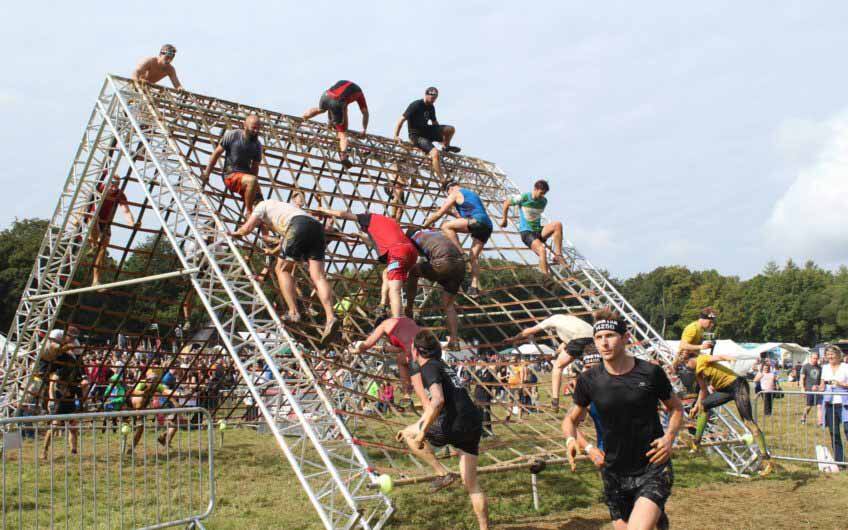OCR Obstacles Demystified: What Beginners Need to Know Before Competing
Understanding the Most Common OCR Obstacles and Why They Challenge Beginners
Phenomenon: The Most Frequently Encountered OCR Obstacles
Most newbies struggle with vertical walls taller than 8 feet, rope climbs over 15 feet high, and those tricky multi-rig monkey bars. According to the Obstacle Racing Journal from last year, these three obstacles alone cause failure for about six out of ten first time racers in OCR events. What makes them so tough? Well, they require a mix of sudden bursts of strength, long lasting grip, and good sense of where your body is in space something that regular weekend warriors just don't have much practice with. Experienced racers usually refer to these as the Big Three when talking about what really separates the pros from everyone else on the course.
- Overhung walls requiring inverted climbs
- Suspended cargo nets with unstable footing
- Rotating monkey bars that test dynamic grip transitions
Why OCR Obstacles Like Monkey Bars and Rope Climbs Trip Up New Competitors
Novices underestimate how cold hands, muddy grips, and racing-induced adrenaline dumps compound difficulty. A 2022 biomechanics study revealed that wet ropes reduce grip efficiency by 38% compared to dry conditions. Unlike gym training, OCR obstacles force athletes to:
- Maintain contact with moving surfaces (like swinging pipes)
- Execute full-body coordination under fatigue
- Problem-solve mid-obstacle when techniques fail
Case Study: Analyzing High Failure Rates on Key OCR Obstacles
| Obstacle | Failure Rate | Primary Failure Cause | Success Predictor |
|---|---|---|---|
| Typhoon (spinning walls) | 47% | Improper weight distribution | Trapezius endurance |
| Olympus (angled walls) | 53% | Premature forearm pump | Toe-hook technique mastery |
| Twister (rotating bars) | 68% | Failed hand transitions | False grip endurance |
Data from 1,200 first-time racers at 2023 Spartan events shows technique-specific training reduces failure rates by 22–39%.
Trend: How Obstacle Design Has Evolved in Major OCR Events
Modern OCR obstacles increasingly incorporate dynamic elements—rotating planks, counterweighted walls, and water-integrated challenges. This evolution demands fluid adaptability rather than brute strength. Leading race series now use modular obstacle designs that adjust difficulty based on competitor division, weather conditions, and terrain elevation.
Strategy: Proactive Recognition and Mental Mapping of OCR Obstacles
Top coaches recommend studying obstacle blueprints pre-race and practicing "failure scenarios" like one-arm hangs or lateral repositions. Beginners who mapped obstacle sequences in training saw 31% faster completion times compared to improvisers (OCR Tactics Report 2024). Critical preparation steps include:
- Drilling obstacle-specific exits (e.g., controlled dismounts from 10' walls)
- Simulating transition zones between obstacles
- Practicing grip resets on slippery surfaces
Essential Strength and Conditioning for OCR Obstacle Success
Overcoming OCR obstacles requires more than raw endurance—it demands targeted strength development across muscle groups challenged by climbs, carries, and dynamic movements. A 2023 analysis of Spartan Race finishers revealed athletes with structured strength programs had 68% fewer obstacle failures than those relying solely on running fitness.
Building Foundational Strength: Pull-Ups, Burpees, and Push-Ups for OCR
Pull-ups develop the latissimus dorsi and grip endurance critical for rope climbs, while push-ups and burpees build the chest and triceps strength needed for wall traversals. Research shows completing 8–12 strict pull-ups reduces fatigue during rig-based obstacles by 41% compared to basic grip training alone.
Lower Body Power: Lunges, Bear Crawls, and Explosive Jumps
Lunges strengthen unilateral stability for uneven terrain, while bear crawls improve shoulder endurance and hip mobility for under-wall obstacles. A 10-week plyometric jump program increased success rates on 6-foot walls by 33% in novice athletes (OCR Athlete Lab 2024).
Functional Training That Mirrors Real OCR Obstacle Demands
Incorporate sandbag carries, lateral drags, and inverted rope climbs to simulate race-day challenges. These compound movements build the full-body coordination needed to maintain momentum through multi-stage obstacles like the Tyrolean traverse.
Compound Lifts and Plyometrics: Integrating Strength into Weekly OCR Training
| Training Focus | Example Exercises | OCR Obstacle Applications |
|---|---|---|
| Vertical Pull | Weighted pull-ups | Rope ascents, rig ladders |
| Horizontal Push | Bench presses | Wall transitions, sled pushes |
| Explosive Power | Box jumps | Short-wall sprints, hay jumps |
A balanced program pairing deadlifts and kettlebell swings with grip-specific holds prepares athletes to handle unpredictable loads while conserving energy for later-stage obstacles.
Mastering Grip Strength: The Hidden Key to OCR Obstacle Navigation
The Critical Role of Grip Strength in Overcoming OCR Obstacles
In competitive OCR events, grip strength makes all the difference for around 70% of obstacles encountered during races, whether it's scaling ropes or navigating through rig courses. Looking at data from 2023 regarding why athletes fail obstacles, researchers noticed something interesting: nearly 6 out of 10 failed attempts weren't because competitors lacked overall arm strength, but rather due to their hands giving out too soon. This hidden weakness really matters when conditions get tricky. On slippery surfaces or anything with rough textures, even small reductions in grip effectiveness can turn manageable challenges into major setbacks for racers.
Effective Grip Training: Hangs, Holds, and Transition Drills
Progressive overload through three-phase grip training yields measurable results:
- Dead hangs: Start with 20-second static holds, progressing to 90 seconds with added weight
- Transition drills: Practice bar-to-ring transfers using gymnastics rings to build dynamic control
- Farmer carries: Load 70% of body weight for 40-meter walks to simulate heavy carries
A 6-week focused program can increase grip endurance by 23% (Journal of Functional Training, 2022), with compound lifts like kettlebell swings providing complementary forearm engagement.
Debate: Is Grip Strength More Important Than Upper Body Power in OCR?
While raw pulling power helps scale walls, grip endurance dictates multi-obstacle efficiency. Elite athletes balance both:
| Training Focus | Contribution to OCR Success |
|---|---|
| Grip Endurance | 65% of total obstacle time |
| Upper Body Power | 35% of explosive movements |
The consensus from Spartan Race champions suggests prioritizing grip capacity first—competitors rarely fail obstacles due to lack of pulling strength, but consistently fail from slipping grips.
Developing Agility, Endurance, and Coordination for Efficient Obstacle Racing
Agility and Coordination Drills to Improve Obstacle Flow
Drills like lateral ladder shuffles, box step-overs, and cone weave sprints build the footwork precision needed for wall traverses and balance beams. A 2023 analysis of OCR race results showed athletes who incorporated 3 weekly agility sessions reduced their obstacle completion times by 19% compared to those focusing solely on strength.
Balancing Cardiovascular Endurance and Recovery in OCR Training
Getting OCR right means finding that sweet spot between tough endurance work and proper rest periods. Many athletes swear by mixing things up with workouts that include both 400 meter sled pushes and those intense one minute rope climbs, since this combo really mirrors what happens on race day and builds serious stamina over time. The numbers tell us something interesting too sports physiologists have found that around two thirds of newcomers push themselves way too hard during those last few weeks before competition. To stay sharp without burning out, most coaches recommend alternating days of heavy lifting with lighter activities such as yoga or even a quick swim session now and then. These recovery options help keep joints loose while avoiding that dreaded burnout feeling that can wreck all your hard work.
Sample 6-Week OCR Training Plan for First-Time Competitors
A phased approach builds competence systematically:
| Week Phase | Focus Area | Key Workouts |
|---|---|---|
| Weeks 1-2 | Base Conditioning | Hill repeats + grip drills |
| Weeks 3-4 | Obstacle Simulation | Sandbag carries + rig laps |
| Weeks 5-6 | Race-Specific Pacing | Timed obstacle circuits |
This progression develops the work capacity needed to handle 8–12 obstacles per mile while minimizing injury risks. New competitors using structured plans report 41% higher completion rates compared to unstructured training.
Mental Strategies to Overcome Fear and Master Challenging OCR Obstacles
Common Psychological Barriers at Rope Climbs, Walls, and Heights
Over 68% of first-time OCR competitors report freezing or hesitating at elevated obstacles like 12-foot walls and 30-foot rope climbs (Extreme Sports Journal 2023). Three psychological barriers dominate:
- Height-induced paralysis: The brain's innate survival response to perceived fall risks
- Grip anxiety: Fear of losing hand strength mid-obstacle
- Momentum disruption: Overthinking transitions between obstacles
Building Confidence Through Repetition, Visualization, and Exposure
Elite coaches recommend a three-phase mental training protocol:
- Obstacle simulation: Practice rope climbs on angled structures (45–60° inclines) to mimic competition-grade ropes
- Sensory deprivation drills: Complete wall traverses wearing mittens to simulate muddy race conditions
- Progressive exposure: Start with 50% obstacle height, increasing 10% weekly until reaching competition specifications
Mental Preparation Techniques Used by Elite OCR Athletes
Top competitors employ neuroscience-backed strategies:
| Technique | Implementation | Performance Impact |
|---|---|---|
| Tactical breathing | 4-7-8 pattern during obstacle approaches | 22% faster recovery (OCR Athletic Commission 2023) |
| Micro-goal setting | Breaking walls into 3-step sequences | 41% reduction in perceived difficulty |
| Predictive failure analysis | Visualizing recovery from slips | 37% improvement in obstacle reattempt success |
Military-style "stress exposure" training shows a 29% greater confidence boost than standard visualization alone, according to a 2024 study of 1,200 OCR athletes.


